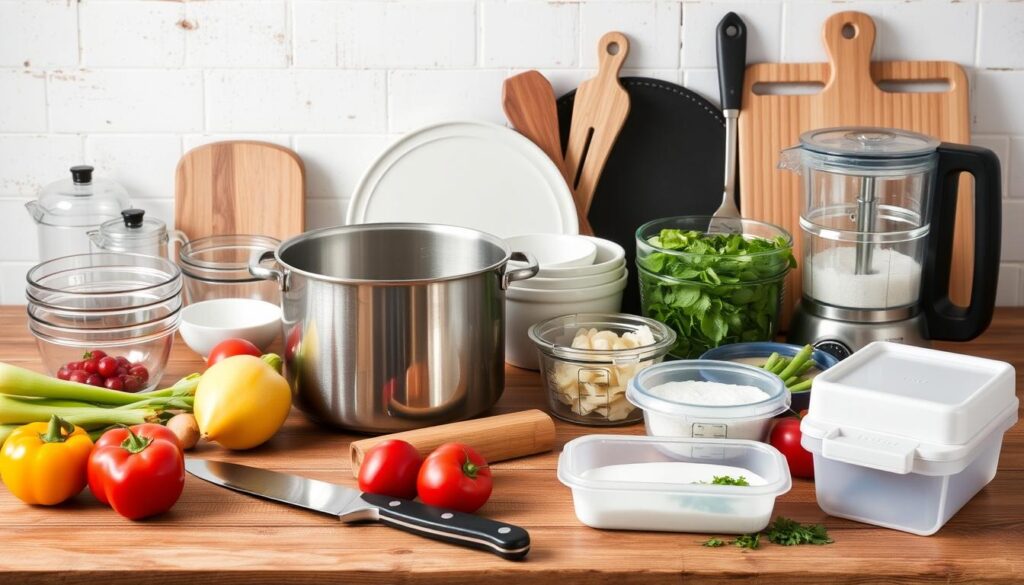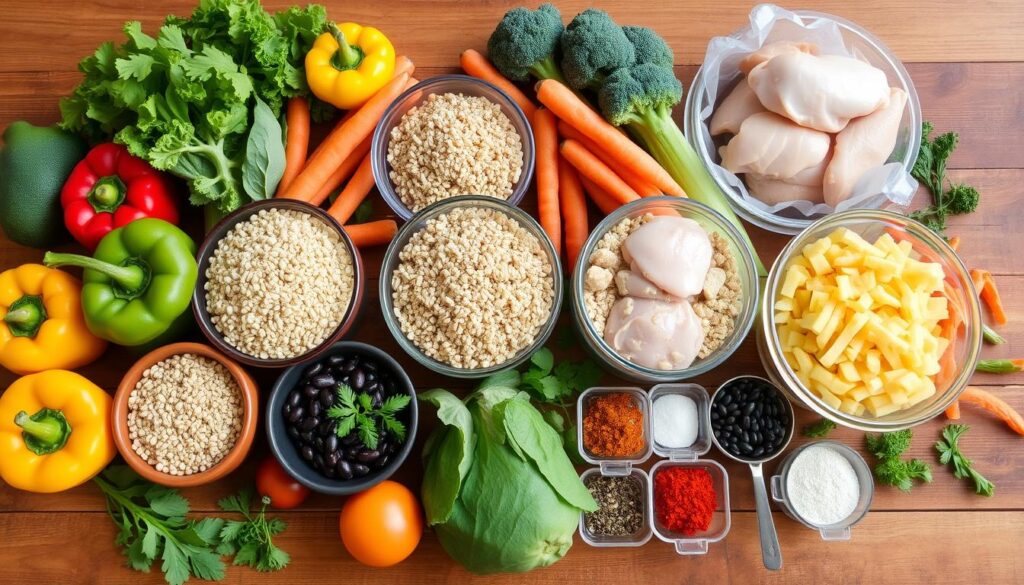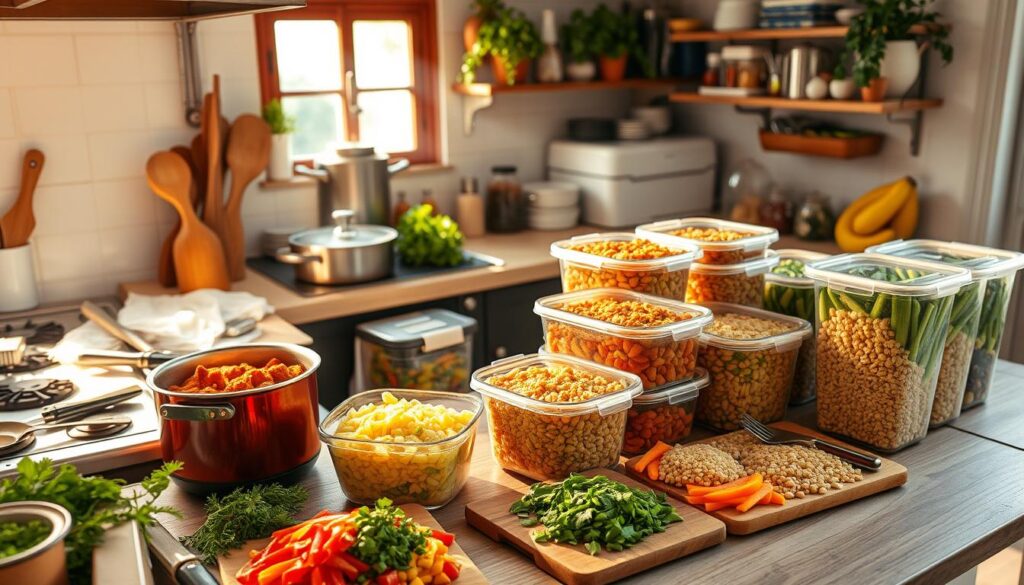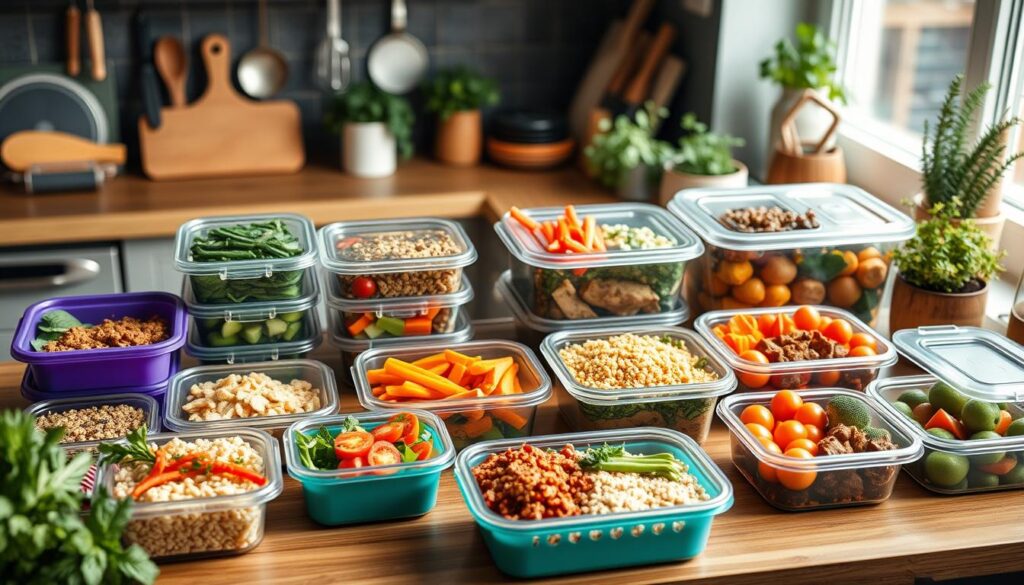Feeling stressed about cooking every day? Batch cooking could be the answer. It’s a smart way to make meals in advance. This helps busy people and families save time and enjoy tasty meals all week.
Bulk cooking is more than a trend. It’s a smart way to manage your diet and kitchen work. By cooking many meals at once, you can make food prep easier and less stressful.
Whether you’re new to cooking or want to make meal prep better, this guide is for you. It covers the basics of make-ahead meals and easy cooking tips. These can change how you cook at home.
Key Takeaways
- Learn the fundamentals of efficient meal prep
- Discover time-saving bulk cooking techniques
- Understand how batch cooking can reduce daily stress
- Explore cost-effective meal planning strategies
- Master beginner-friendly cooking approaches
What is Batch Cooking and Why Should You Start
Batch cooking is a smart way to prepare meals. It lets you cook many meals at once, saving time. By spending a few hours on strategic meal preparation, you can make your week easier and cut down on cooking stress.
Batch cooking is all about being efficient and managing your time well. It lets you cook big batches of food that you can eat all week. This is perfect for people who are always busy.
Time-Saving Benefits of Batch Cooking
Batch cooking offers more than just convenience. It saves you time on busy days. Here are some key benefits:
- Less time spent cooking
- Cleaner kitchen
- Always have a meal ready
- Less stress about what to eat
Cost-Effective Meal Planning
Batch cooking also helps you save money. Buying ingredients in bulk and cooking many meals at once cuts down on costs. It also reduces food waste.
| Cooking Method | Weekly Cost | Time Spent Cooking |
|---|---|---|
| Daily Cooking | $120 | 10-12 hours |
| Batch Cooking | $80 | 4-5 hours |
Health Benefits of Home-Prepared Meals
Batch cooking helps you control what you eat. Home-prepared meals let you choose better ingredients and control portions. This way, you can eat healthier and reach your wellness goals.
“Batch cooking is not just about saving time—it’s about creating a sustainable, healthy eating strategy.” – Nutrition Expert
Essential Kitchen Equipment for Successful Batch Cooking
Batch cooking needs the right kitchen tools and equipment. These make the process easier and more fun. The right tools can change batch cooking from hard to easy.

You don’t have to spend a lot on good kitchen tools. Smart cooks choose tools that do many things. This saves money and space.
- Large Stockpots: Perfect for preparing big batches of soups and stews
- Food Processors: Chop vegetables quickly and uniformly
- High-Quality Baking Dishes: Ideal for casseroles and sheet pan meals
- Sturdy Cutting Boards: Essential for efficient meal preparation
Pro tip: Look for kitchen tools that serve multiple purposes to save money and storage space.
| Kitchen Tool | Batch Cooking Function | Estimated Cost |
|---|---|---|
| Instant Pot | Multi-cooking: pressure, slow cook, sauté | $80-$150 |
| Large Food Storage Containers | Portion and store prepared meals | $20-$50 set |
| Stand Mixer | Mixing, kneading, multiple attachments | $200-$350 |
“The right cooking equipment can turn meal prep from a chore into a creative and enjoyable process.” – Professional Chef
When picking food storage containers, look for durability and leak-proof design. Make sure they work in the microwave and freezer. Glass containers with tight lids are the best for keeping meals fresh.
Getting Started: Planning Your First Batch Cooking Session
Starting your batch cooking journey needs careful planning and preparation. Good meal planning turns your kitchen into a time-saving powerhouse. It also reduces daily stress.

Effective batch cooking begins with a solid plan. Your food prep schedule is your guide for efficient meal prep. It helps you use your time and resources wisely.
Creating Your Shopping List
Smart grocery shopping is key to a great batch cooking experience. Here are some tips:
- Check what you already have in your pantry
- Buy ingredients that fit in many recipes
- Save money by buying in bulk
- Choose fresh, versatile ingredients
Scheduling Your Prep Day
Pick a day for batch cooking with few distractions. Weekends are often best for most cooks.
“Preparation is the key to successful batch cooking. Plan your day, gather your tools, and approach cooking systematically.” – Professional Chef Recommendation
Storage Container Requirements
Good meal prep containers are essential for keeping your meals fresh. Look for:
- Microwave-safe options
- Leak-proof seals
- Stackable designs
- BPA-free materials
Pro tip: Choose containers in various sizes for different meal portions and types.
Best Ingredients for Batch Cooking Success

Choosing the right ingredients is key for batch cooking success. Home chefs know that using pantry staples and long-lasting produce makes meal prep easier. It turns a chore into a strategy.
When you plan your batch cooking, pick ingredients that stay fresh and tasty. Freezer-friendly foods are your secret to making delicious meals ready to eat.
- Proteins that excel in batch cooking:
- Chicken breasts
- Ground turkey
- Lean beef
- Tofu
- Vegetables with extended shelf life:
- Carrots
- Broccoli
- Cauliflower
- Spinach
Grains are crucial in batch cooking. Rice, quinoa, and barley keep well and add nutritional value.
“The key to successful batch cooking is choosing ingredients that retain flavor and texture, even after refrigeration or freezing.” – Professional Meal Prep Chef
| Ingredient Category | Storage Duration | Batch Cooking Suitability |
|---|---|---|
| Whole Grains | 5-7 days refrigerated | Excellent |
| Legumes | 4-5 days refrigerated | Very Good |
| Roasted Vegetables | 3-4 days refrigerated | Good |
By picking ingredients that last longer, you’ll make batch cooking more efficient. You’ll enjoy tasty, home-cooked meals all week.
Batch Cooking for Beginners: Easy Meals to Prep in Bulk
Learning to make batch breakfast recipes and freezer meals can change your meal planning. It saves time, cuts down stress, and helps you eat healthy even when you’re busy.

Good meal prep recipes need careful planning and smart cooking tips. Let’s look at tasty and easy batch cooking options for every meal.
Make-Ahead Breakfast Options
Batch cooking breakfast can make mornings easier. Here are some easy make-ahead ideas:
- Overnight oats with different flavors
- Egg muffin cups with veggies
- Chia seed puddings
- Frozen breakfast burritos
Freezer-Friendly Lunch Ideas
Meal prep recipes for lunch can make your midday meals fun and healthy. Try these easy-to-carry options:
- Mason jar salads
- Quinoa and bean bowls
- Wrap fillings ready to go
- Mediterranean grain containers
Family-Size Dinner Preparations
Batch cooking is great for family dinners. Here are some ideas:
- Lasagna in portions for everyone
- Chili with your favorite toppings
- Sheet pan chicken with roasted veggies
- Slow cooker pulled pork
“Batch cooking turns meal prep from a daily task into a smart, time-saving strategy.” – Meal Prep Expert
Pro tip: Always label your containers with what’s inside and the date. It helps keep track of freshness and rotation.
Storage Solutions and Food Safety Guidelines
Learning how to store food properly is key to keeping your meals fresh and safe. The right way to store food in the fridge and freezer can make your meals last longer. It also helps avoid food poisoning.
“Smart storage is the secret to successful meal preparation.” – Professional Chef’s Guidebook
To keep your meals safe, you need to know the best storage methods. Each food type needs special care to stay tasty and healthy.
- Cool hot foods to room temperature within 2 hours
- Use airtight containers for storage
- Label containers with preparation date
- Maintain refrigerator temperature at 40°F or below
Here’s a detailed guide to safely storing your meals:
| Food Type | Refrigerator Storage | Freezer Storage |
|---|---|---|
| Cooked Meats | 3-4 days | 2-6 months |
| Soups and Stews | 3-4 days | 4-6 months |
| Casseroles | 3-4 days | 2-3 months |
Good freezer organization saves space and makes your meals easy to find. Use clear containers and mark each dish with a permanent marker.
Pro tip: Invest in high-quality, freezer-safe containers with tight-sealing lids to prevent freezer burn and maintain food quality.
Time-Saving Batch Cooking Techniques
Mastering kitchen efficiency means finding smart ways to make meal prep faster. Cooking hacks can cut down your kitchen time. This way, you can always have healthy, tasty meals ready.
Batch cooking works best with good planning and time management. Professional cooks know that getting ready is crucial. It helps make many meals quickly and well.
Efficient Chopping Methods
Chopping is often the longest part of meal prep. Here are some tips from chefs:
- Invest in a high-quality chef’s knife
- Use a cutting board with non-slip surface
- Practice uniform cutting techniques
- Sharpen knives regularly for precision
Multi-Tasking in the Kitchen
Boost your cooking speed with smart multi-tasking:
- Preheat ovens while preparing ingredients
- Start long-cooking items first
- Clean as you go to reduce post-cooking mess
- Use multiple cooking surfaces simultaneously
Assembly Line Organization
| Technique | Time Saved | Difficulty Level |
|---|---|---|
| Ingredient Prep Station | 30-45 minutes | Easy |
| Batch Cooking Layout | 45-60 minutes | Intermediate |
| Simultaneous Cooking | 60-90 minutes | Advanced |
“Efficiency is doing things right; productivity is doing the right things.” – Peter Drucker
Using these kitchen tips will make batch cooking fun. Remember, the more you practice, the better you’ll get!
Common Batch Cooking Mistakes to Avoid
Batch cooking can change the game for busy cooks. But, there are meal prep pitfalls to watch out for. Knowing and avoiding common mistakes is key to a smooth process.
“Preparation is the key to successful batch cooking. Know your potential mistakes before they happen.”
Experienced cooks know that food storage mistakes can ruin a batch cooking session. Let’s look at the main errors to avoid:
- Overcrowding cooking surfaces, which leads to uneven heating
- Inadequate cooling before storage
- Using incorrect or low-quality storage containers
- Neglecting proper labeling
Batch cooking tips stress the need for planning and smart techniques. Here’s a detailed look at common issues:
| Mistake | Potential Consequence | Prevention Strategy |
|---|---|---|
| Inconsistent portioning | Waste and uneven meal sizes | Use measuring tools and standardized containers |
| Poor ingredient selection | Reduced meal quality | Choose ingredients that freeze and reheat well |
| Ignoring food safety | Potential health risks | Monitor cooking temperatures and storage times |
Pro tip: Invest in high-quality, airtight storage containers and a reliable food thermometer to minimize cooking errors and ensure meal prep success.
By understanding these common pitfalls, you can make your batch cooking consistently delicious and efficient.
Meal Rotation and Variety Planning
Keeping your meals exciting is key to success. Batch cooking doesn’t mean you have to eat the same thing every day. By rotating your menu, you can make home cooking fresh and fun.
Having a variety of recipes is important to avoid getting bored with food. A dynamic meal calendar helps you use your batch cooking wisely. It also makes sure you eat a balanced diet.
Weekly Meal Calendar Creation
Creating a good weekly meal calendar takes creativity and planning. Here are some important tips:
- Mix protein sources across different days
- Alternate cooking styles (baked, grilled, stir-fried)
- Incorporate international cuisine themes
- Plan flexible base recipes that can be transformed
Preventing Food Fatigue
To keep meals exciting, try these ideas:
- Use flavor-boosting ingredients like herbs and spices
- Create modular meal components
- Experiment with unexpected ingredient combinations
“Variety is the spice of life – and the secret to sustainable meal planning.” – Culinary Experts
By embracing menu rotation and creative meal planning, batch cooking becomes a fun adventure in the kitchen.
Budget-Friendly Batch Cooking Strategies
Mastering economical cooking doesn’t mean you have to give up on taste or nutrition. Frugal meal prep is an art that can save you a lot of money. It also gives you delicious, home-cooked meals.
Smart grocery savings start with planning. Using bulk buying tips can change your kitchen budget. It can also lower your overall food expenses.
- Purchase non-perishable ingredients in larger quantities
- Shop seasonal produce for lower prices
- Compare unit prices instead of package prices
- Use loyalty programs and digital coupons
“The key to budget-friendly batch cooking is planning and smart shopping.”
Choosing the right ingredients is key in frugal meal prep. Look for versatile, affordable proteins like:
- Dried beans
- Chicken thighs
- Eggs
- Canned fish
Pro tip: Freeze portions of bulk-purchased ingredients to extend their usability and prevent waste.
Maximize your grocery savings by making meal plans that use similar ingredients. This way, you reduce waste and buy more efficiently.
Conclusion
Batch cooking changes how you make meals, offering a smart way for busy people to save time and eat healthy. By using the tips from this guide, you can make your kitchen work easier. You’ll always have nutritious meals ready.
Batch cooking does more than save time. It also reduces stress, cuts down on food waste, and saves money. It’s not just about cooking faster. It’s about living a healthier, more balanced life.
Begin with small steps and grow your skills with each try. It takes time to get good at batch cooking. Don’t worry if it’s not perfect at first. Every attempt brings you closer to being a pro at making healthy meals easily.
Batch cooking is more than just cooking. It’s a way to improve your health and manage your time better. By spending a few hours each week on meal prep, you open up a world of possibilities. You’ll save money and have more time for things you enjoy.
FAQ
What exactly is batch cooking?
Batch cooking means cooking a lot of food at once. You make enough for several meals that you can store and eat later. It saves time, reduces stress, and ensures you have healthy meals ready.
How long can batch-cooked meals be safely stored?
You can store most meals in the fridge for 3-4 days. Freezer storage is 2-3 months. Use airtight containers and label them with the cooking date.
Do I need special equipment to start batch cooking?
You don’t need a lot of equipment to start. Useful items include large pots, baking dishes, and containers. A slow cooker or instant pot can also help.
How can batch cooking save me money?
Batch cooking saves money by reducing waste and buying in bulk. It helps avoid expensive takeout. Plan meals around sales and seasonal produce.
Is batch cooking good for special diets?
Yes! It’s great for special diets like vegetarian, vegan, gluten-free, or low-carb. You control ingredients and portion sizes, making it easier to follow your diet.
Can I batch cook if I live alone?
Yes! Batch cooking is perfect for singles. Cook smaller amounts, portion them out, and freeze individual servings. This way, you have home-cooked meals without daily cooking.
How do I prevent my batch-cooked meals from tasting boring?
To keep meals exciting, use different seasonings and recipes. Prepare versatile ingredients that can be used in many ways. Mix up your protein sources and use herbs and spices to add variety.
What are the best foods for batch cooking?
Great foods for batch cooking include:- Proteins like chicken, ground meat, and beans- Grains such as rice, quinoa, and pasta- Roasted vegetables- Soups and stews- Casseroles- Breakfast items like egg muffins and overnight oats
How much time does batch cooking typically take?
Batch cooking usually takes 2-4 hours. Many people cook on Sundays to prepare meals for the week. This saves a lot of time during the week.
Can I reheat batch-cooked meals safely?
Yes, but follow safety rules. Reheat to 165°F (74°C), use microwave-safe containers, and stir. Avoid reheating the same portion too many times.
Share this post: on Twitter on Facebook

